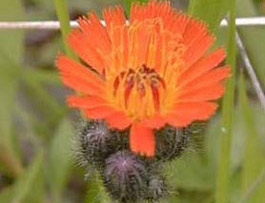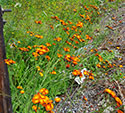Orange Hawkweed
Hieracium aurantiacum • Class B |
||
| Family Name: | Asteraceae family (ass-ter-AY-see-ee) | |
| Common: | Aster, daisy, or sunflower family | |
| Genus: |
Hieracium (hi-er-uh-KEE-um) Meaning: From the Greek meaning a hawk, referring to belief that hawks fed on the plant to strengthen eyesight |
|
| Species: |
aurantiacum (aw-ran-ti-AYE-kum) Meaning: Orange-red colored |
|
| Description: |
Plants have a basal rosette of narrow, pointed leaves that are 4 to 6 inches long and may be smooth or hairy, but are not woolly underneath like the Mouse-ear hawkweed. Orange hawkweed produces 5 to 30 compact, flowerheads consisting of only ray flowers, that are bright red on the edges and orange in the center. Flowerheads grow in compact to open clusters of 3 to 7, or more. Bracts at the base of the flowerheads are hairy. Flowering stems stand from a few inches to 2 feet tall and are leafless, covered with stiff hairs, and contain a milky sap. |
| Why Is it a Noxious Weed? |
It forms dense mats which prevent other plants from establishing seedlings crowding out native species and desirable vegetation. It is an aggressive competitor for pasture and rangeland. |
| Where Does it Grow? |
Orange hawkweed infests wetlands and lawns and is especially invasive on poorer acidic soils. It is an aggressive competitor for pastures, meadows, native grasslands. It prefers full to partial sunlight. It is unpalatable and crowds out more palatable species. |
| Facts: |
Orange hawkweed is one of only 6 known Pollen Allelopathic plants. The pollen released from its flowers releases toxins that inhibit the seed germination, seedling emergence, and sporophytic growth of surrounding plants. |
| Control Options: |
|
| More Information: |
Download our Flyer or visit Washington State Noxious Weed Control Board Here. Photo by Leo Michels
|
| More Pictures: |



